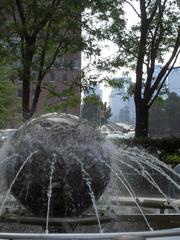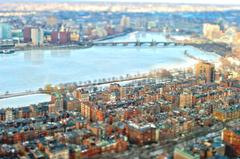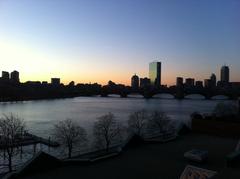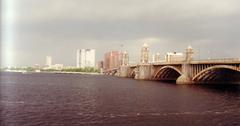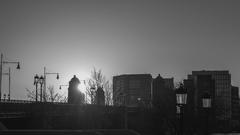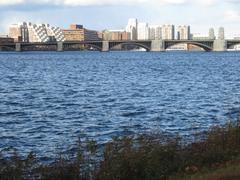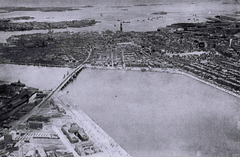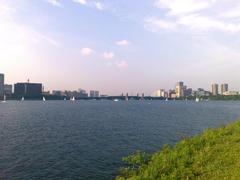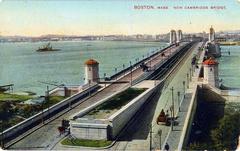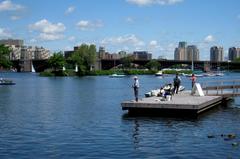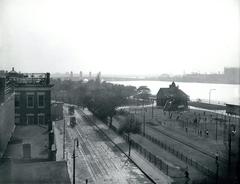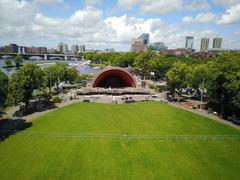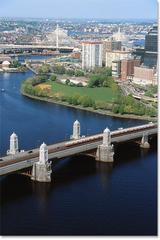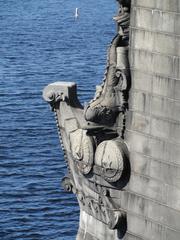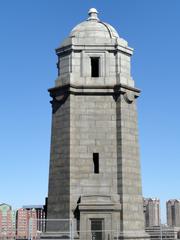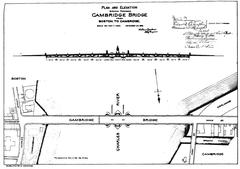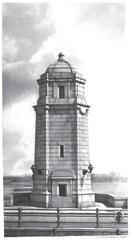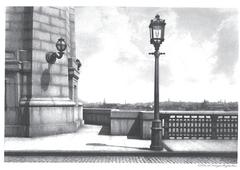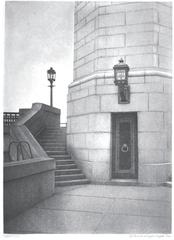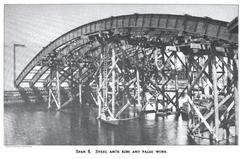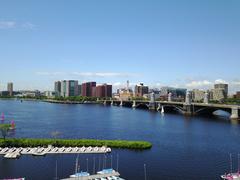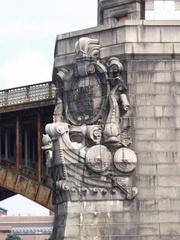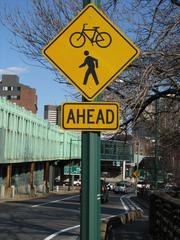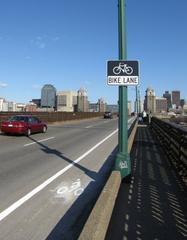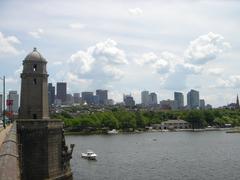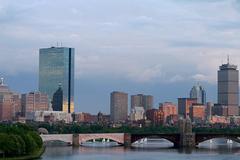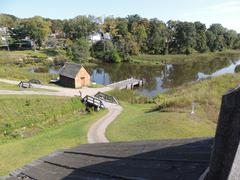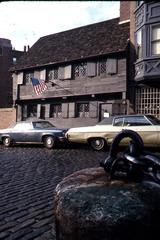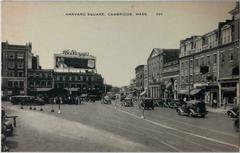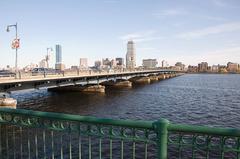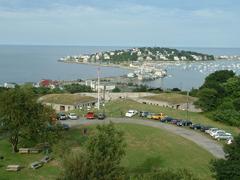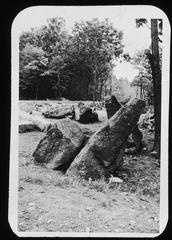
Guide to Visiting Longfellow Bridge, Boston
Date: 24/07/2024
Introduction
The Longfellow Bridge, an iconic structure connecting Boston and Cambridge, Massachusetts, is not just an essential transportation link but also a historical and architectural marvel. Named after the esteemed poet Henry Wadsworth Longfellow, this bridge embodies centuries of history, engineering excellence, and cultural significance. Originating as a humble ferry service in the 1630s, it evolved into the grand structure we see today, reflecting the artistic and urban planning ambitions of the early 20th century (Wikipedia). Its distinctive design, featuring eleven arches and four ornamental granite towers, has earned it the affectionate nickname ‘salt and pepper shakers’ among locals (Boston Preservation).
This guide provides a comprehensive look at the Longfellow Bridge, detailing its rich history, architectural significance, and practical visiting information. Whether you’re a history enthusiast, an architecture aficionado, or simply a curious visitor, this guide will equip you with everything you need to know to appreciate this Boston landmark fully.
Table of Contents
- Introduction
- History of the Longfellow Bridge
- Visiting the Longfellow Bridge - Practical Information
- Cultural and Community Impact
- Frequently Asked Questions (FAQs)
- Conclusion
History of the Longfellow Bridge
Early Beginnings and Initial Constructions
The site of the Longfellow Bridge has a rich history dating back to the 1630s when the first river crossing was established as a ferry service (Wikipedia). This ferry connected the burgeoning settlements of Boston and Cambridge, facilitating early trade and communication. The first significant structure, the West Boston Bridge, was constructed in 1793 by a group of private investors with a charter from the Commonwealth. This toll bridge was a timber-pile structure that connected Bowdoin Square in Boston with the commercial side of Cambridge, forever altering both neighborhoods (Boston Preservation).
The Cambridge Bridge Era
In 1900, recognizing the need for a more robust and modern structure, the state of Massachusetts initiated the construction of a new bridge. The Cambridge Bridge, as it was initially known, was designed by chief engineer William Jackson and architect Edmund Wheelwright. The design was inspired by the artistic style of European bridges and was part of the City Beautiful Movement, which aimed to introduce beautification and monumental grandeur in urban planning (History Cambridge). Construction began in July 1900, and the bridge opened to traffic in August 1906. It was formally dedicated on July 31, 1907 (Wikipedia).
Renaming to Longfellow Bridge
In 1927, the Cambridge Bridge was renamed the Longfellow Bridge by the Massachusetts General Court to honor the local poet Henry Wadsworth Longfellow. Longfellow had immortalized the predecessor West Boston Bridge in his 1845 poem “The Bridge,” which depicted his emotional journey and connection to the span (History Cambridge). The renaming coincided with the centennial of Longfellow’s birth, reflecting the cultural and historical significance of the poet to the local community.
Architectural and Engineering Marvel
The Longfellow Bridge is renowned for its architectural and engineering excellence. The bridge features eleven arches supported on ten piers, with four ornamental granite towers known as the “salt and pepper shakers” due to their distinctive shape (Wikipedia). Each tower is made up of 515 Rockport granite stones, weighing up to three tons apiece. The towers are adorned with the prows of Viking ships, a nod to the purported voyage of Leif Eriksson up the Charles River around 1000 AD, promoted by Harvard professor Eben Horsford (Wikipedia).
Legislative and Regulatory Challenges
The construction of the Longfellow Bridge faced several legislative and regulatory challenges. Initially, both state and national regulations required a drawbridge to allow for river navigation. However, it became evident that a bridge without a draw would be cheaper, more aesthetically pleasing, and less disruptive to traffic. Consequently, the state altered its regulations, and after the War Department declined to follow suit, the United States Congress passed an act permitting the bridge, which President William McKinley signed on March 29, 1900 (Wikipedia).
Major Repairs and Rehabilitation
Over the years, the Longfellow Bridge has undergone several major repairs and rehabilitation projects to address structural deficiencies and preserve its historic character. The first significant repairs occurred in 1959. More recently, a comprehensive rehabilitation project was undertaken to upgrade the bridge’s capacity and bring it up to modern codes while preserving its visual and architectural quality. This project involved dismantling, cleaning, restoring, and re-erecting the 58-foot-tall towers that frame the river’s navigation channel (Wikipedia).
Modern-Day Significance
Today, the Longfellow Bridge is considered one of the most important historic bridges in Boston due to its prominent location over the Charles River and its outstanding visual and architectural quality (Wikipedia). The bridge carries Massachusetts Route 3, the MBTA Red Line, bicycle, and pedestrian traffic, serving approximately 28,600 cars and 90,000 mass-transit passengers every weekday (Wikipedia). It also provides a panoramic view of the Boston skyline, making it a popular spot for both locals and tourists.
Visiting the Longfellow Bridge - Practical Information
Visiting Hours and Accessibility
The Longfellow Bridge is accessible to the public 24/7. There are no specific visiting hours or ticket requirements for walking or biking across the bridge. However, those interested in special tours or events should check with local tourism boards or historical societies for up-to-date information.
Nearby Attractions
Visitors to the Longfellow Bridge can also explore several nearby attractions. These include the Esplanade, a beautiful park along the Charles River, the Museum of Science, and the historic Beacon Hill neighborhood. Each of these sites offers a unique glimpse into Boston’s rich cultural and historical heritage.
Travel Tips
- Best Time to Visit - Early mornings or late afternoons are ideal for avoiding heavy traffic and enjoying the scenic views in a more relaxed atmosphere.
- Photography Spots - The bridge itself, especially the “salt and pepper shakers,” offers excellent photographic opportunities. The views of the Boston skyline are particularly stunning at sunrise and sunset.
- Accessibility - The bridge is pedestrian and cyclist-friendly, with dedicated lanes ensuring safety for all visitors.
Cultural and Community Impact
The Longfellow Bridge has also become a cultural landmark with unique community projects. One such project is the “hidden hall of fame” under the bridge, where hundreds of trophies and medals are displayed. This DIY landmark started in 2014 when an anonymous individual began placing trophies under the bridge, and it quickly grew into a community project celebrating the achievements of Bostonians (Boston Uncovered).
Frequently Asked Questions (FAQs)
Q: Are there any guided tours available for the Longfellow Bridge? A: While there are no regular guided tours specifically for the Longfellow Bridge, several local historical societies and tour companies offer walking tours that include the bridge as part of their itinerary.
Q: Is the Longfellow Bridge wheelchair accessible? A: Yes, the Longfellow Bridge is wheelchair accessible, with ramps and smooth pathways suitable for all visitors.
Q: Can I visit the Longfellow Bridge at night? A: Yes, the bridge is open 24/7, and nighttime visits offer a unique perspective with the city lights reflecting off the Charles River.
Conclusion
The Longfellow Bridge stands as a testament to Boston’s rich history, architectural innovation, and community spirit. Its journey from a simple ferry crossing to a monumental steel rib arch bridge reflects the city’s evolution and its commitment to preserving its cultural heritage. Whether you’re a history enthusiast, an architecture aficionado, or a casual visitor, the Longfellow Bridge offers a unique glimpse into Boston’s past and present. Don’t forget to check out other historical sites in the area and share your experiences on social media to inspire others to explore this iconic landmark (History Cambridge).
